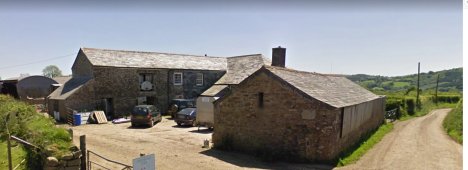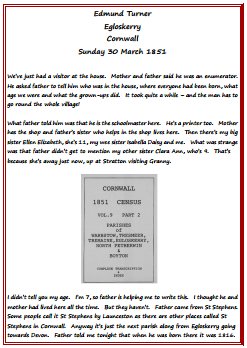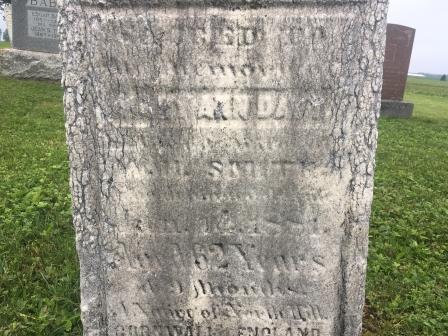
DAVY |
|
From 1809 to 1856 John Davy lived in North Hill and latterly farmed at Glubhole Farm. The story of this brief sojourn of the Davy family in North Hill commences with the sad death of 25 year old John Peter. He was a member of the long established Peter family of North Hill, some of whom are still in the parish today. |
|
|
The Peter Family John Peter was born in 1784, the son of Arthur Peter and Mary (nee Aunger). John's lineage can be traced back to before the English Civil War and includes the Luskey family. Both the Peter and Luskey families were North Hill families of the gentleman class and held land as both owners and occupiers, in the parish and elsewhere. Indeed, when John's grandfather, Arthur Peter (1703-1773) died a decade before John was born, his estate included property in North Hill, Linkinhorne, St Cleer and Davidstow. Whilst the Peter and Luskey families were not as high in status as the Rodd family of Trebartha Hall, nonetheless they were influential in and around the area. John Peter had married in St Torney's in the spring of 1807 to Ann Cullis from Werrington and it is probable that she married above the social status of the time. She had two sisters and all three were the illegitimate daughters of Joan Cullis of Werrrington. John, on the other hand, was the younger of two brothers. Their father was the eldest surviving son of Arthur Peter, the one who had property in the places described above. Whilst it is expected that John's elder brother would receive the bulk of the Peter estate at the appropriate time, it is probable that John was also reasonably wealthy. After 2½ years of his marriage to Ann, which had produced no children, John died in September 1809 aged 25. He had written his will shortly after their marriage in 1807 and, other than a bequest of £10 to his 5 year old niece, Jane Foott, he left his entire estate of property and personal effects to his wife. Ann Peter remarried to John Davy in St Torney's just before Christmas 1809, just 99 days after the burial of her husband. John Davy John Davy's life before he married Ann is not known. At the time of their marriage he was recorded as a tailor. This was not usually considered in rural communities to be an occupation that provides any wealth. In the 1851 census his birthplace is recorded as Tavistock in Devon and from his age it seems he was born about 1787, as was Ann. It will be clear from the following paragraphs that amongst other places the couple had significant interests in the tenements of Churchtown, Glubhole and Addicroft, all in North Hill. Their wealth can be explained by the inheritance received by Ann upon her first husband's death. Under the property laws at the time Ann's possessions would become her new husband's possessions upon their marriage. If John Davy had any personal wealth before the marriage, the record that informs us of this has not been found. The day before their wedding they entered into a pre-nuptial agreement that confirmed the tenancy of some lands they owned to Edward Coumbe (1754-1830), the landlord of the Ring o' Bells tavern in North Hill. This transaction may be honouring an agreement between John Peter, before his death, and Edward Coumbe. The lands in question were primarily part of the Glubhole and Churchtown tenements. Edward would have farmed the land, employing agricultural labourers to do the bulk of the work. The Davy surname, with spelling variants such as Davey and Davie, is a common name in Cornwall and Devon but in North Hill the incidence of the name is much less. It would appear to be more than coincidence, therefore, that the innkeeper Edward Coumbe's brother, John Coumbe, married a Mary Davy in North Hill in 1774. The family link between John Davy and Mary Davy, if it exists, has not been found in the available records. According to Truly Rural John Davy was a yeoman and was strongly involved with the Methodist Wesleyan movement in North Hill. In 1827 he was a teacher at the chapel; in 1834 a class instructor; in 1832/4 a school superintendent. John and Ann had two children, both daughters and they named them Elizabeth and Mary Anne. It isn't likely that they were twins but they were baptised together in St Torney's church on 12 May 1818, Elizabeth probably being a toddler and Mary Anne a baby. Legal Transactions
(Extract from the tithe map has been reproduced with the kind permission of Kresen Kernow ref: AD1409/1)
The Cornish Economy and Emigration The following has been taken from "Cornish Studies Resources - The Great Emigration" by Bernard Deacon. This is an important component in the story of the Davy family, as with many other Cornish families. "The history of the Cornish mining industry is key to understanding the history of Cornish emigration. As early as the 1820s Cornish miners were sought after for their skills and migrated, often on temporary contracts, to Central and South America as well as to metal mines in Wales and northern England. In the 1830s and 40s, this trickle became a flood as mass emigration began to North America. Some of this was at first from marginal and impoverished farming districts in north Cornwall but the majority was from mining areas that at this time were still growing. Later, when the economic tide turned against Cornish mining in the 1870s, it was the declining rural mining parishes that supplied the bulk of migrants. "Most emigrants from the 1840s to the 1870s went to Australia or North America, although the Australian stream was reduced thereafter while emigration to the States continued at a high level. In the 1890s there was a short-term surge to South Africa as gold mines were opened up in the Transvaal. By the 1900s inter-continental movement of Cornish miners was well-established, moving between overseas destinations and returning to Cornwall, depending on the changing fortunes of the global mining economy." John and Ann's elder daughter - Elizabeth Davy
John and Ann's younger daughter - Mary Anne Davy Mary Anne married a year later in St Torney's to William Hornabrook Smith, also of Egloskerry. William moved to Glubhole and as time went by and John Davy grew older, William took over the running of the farm. Mary Anne had seven children by William and they were all baptised in St Torney's, viz: John (1839); Sydney (1840); Elizabeth Anne (1842); William Davy (1845 - adopting a mother's maiden name as the middle name of a child was commonplace); Eliza Mary (1847); Joseph (1850); Alfred (1852). The family are recorded in "Edmund's account"; click on the image to read it. Emigration to Canada Having settled all their financial dealings it seems that the whole family, John, Ann, the Turners of Egloskerry and the Smiths of Glubhole finalised their plan and emigrated to Ontario in Canada where the family flourished.
The family never forgot their North Hill roots despite living so far away and news of events in the parish reached them in Canada. In March 1911 The Cornish and Devon Post reported on a fund raising venture for the benefit of the North Hill Wesleyan Chapel which was being re-opened after renovation. Part of that report includes the following: "The response to the appeal for help has been liberal in large as well as small sums of money, and in horse labour in drawing material, etc. that to give a list would be too great a labour, but perhaps mention might be made of the fact that not only at home but from the United States and Canada has come financial help and even the green dollar bill, in memory of the old homeland. Some of those are Mr Peter Buckingham and Mrs Sydney Smith, whose late husband's grandmother, Mrs Davey (sic), of Glubhole, gave the land for the chapel, also Mr J Doney and Mr J Foott, have been away from the old home for 30, 40 and 50 years." |
The image at the top of the page is Glubhole Farm, taken in 2009. |

 From 1810 to 1856 John and Ann Davy were parties in several land transactions:
From 1810 to 1856 John and Ann Davy were parties in several land transactions:

